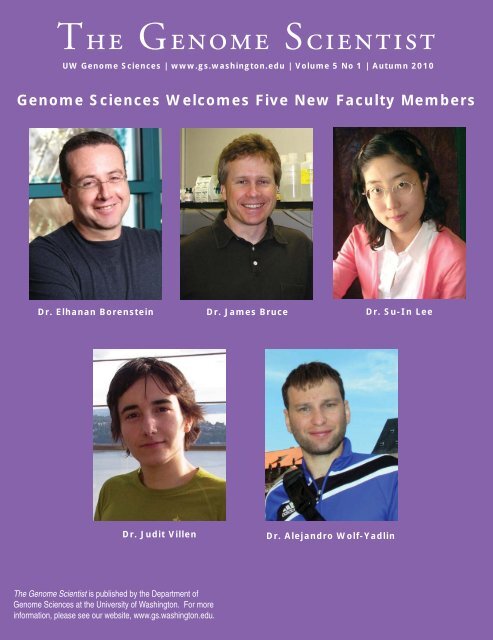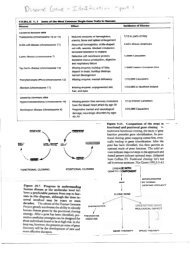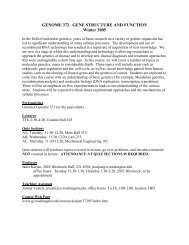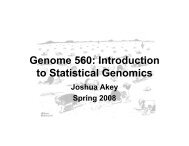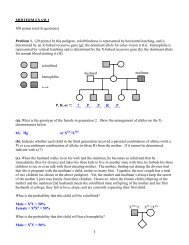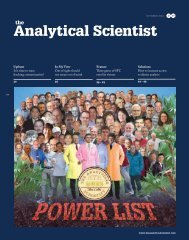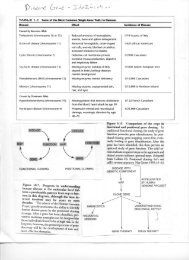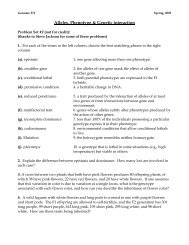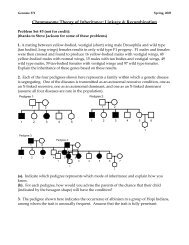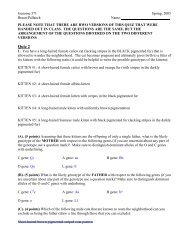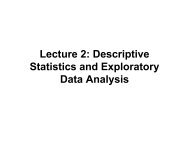Autumn 2010 (pdf) - Genome Sciences - University of Washington
Autumn 2010 (pdf) - Genome Sciences - University of Washington
Autumn 2010 (pdf) - Genome Sciences - University of Washington
You also want an ePaper? Increase the reach of your titles
YUMPU automatically turns print PDFs into web optimized ePapers that Google loves.
The <strong>Genome</strong> Scientist<br />
UW <strong>Genome</strong> <strong>Sciences</strong> | www.gs.washington.edu | Volume 5 No 1 | <strong>Autumn</strong> <strong>2010</strong><br />
<strong>Genome</strong> <strong>Sciences</strong> Welcomes Five New Faculty Members<br />
Dr. Elhanan Borenstein<br />
Dr. James Bruce<br />
Dr. Su-In Lee<br />
Dr. Judit Villen<br />
Dr. Alejandro Wolf-Yadlin<br />
The <strong>Genome</strong> Scientist is published by the Department <strong>of</strong><br />
<strong>Genome</strong> <strong>Sciences</strong> at the <strong>University</strong> <strong>of</strong> <strong>Washington</strong>. For more<br />
information, please see our website, www.gs.washington.edu.
NOTES FROM THE CHAIR<br />
THE GENOME SCIENTIST 2<br />
What a time to be in <strong>Genome</strong> <strong>Sciences</strong>! The<br />
past two years have been an exciting, yet<br />
challenging time.<br />
As you can see from the cover, we have<br />
welcomed five outstanding new faculty into<br />
the Department – Elhanan Borestein, Jim<br />
Bob Waterston<br />
Bruce, Su-In Lee, Judit Villen, and Alejandro<br />
Wolf-Yadlin. They bring real strengths in<br />
computational biology and proteomics to what are already<br />
strong programs. The diversity <strong>of</strong> their backgrounds is striking,<br />
and they connect us with new areas intellectually, on<br />
campus and in the world. You can read more about them on<br />
pp. 6-7; suffice it to say here that we are excited by their arrivals<br />
and expect great things from them in the coming years.<br />
That we were able to add any new faculty in these tough<br />
economic times was itself exciting. In the fall <strong>of</strong> 2008, just as<br />
we were about to launch our search for new faculty, the <strong>University</strong><br />
announced a hiring freeze, and as the recession took<br />
hold in December, the <strong>University</strong> looked again at exceptions<br />
it had granted. Fortunately <strong>Genome</strong> <strong>Sciences</strong> was allowed to<br />
go ahead, and we were rewarded with wonderful new hires.<br />
On the down side, the state has severely cut the <strong>University</strong><br />
budget with some devastating impacts on some departments.<br />
We can only hope that the Governor and Legislature in future<br />
budgets recognize the critical role <strong>of</strong> the <strong>University</strong> in the<br />
future <strong>of</strong> the state.<br />
On the science front, new technologies, particularly DNA<br />
sequencing technologies, are revolutionizing our field, opening<br />
whole new avenues <strong>of</strong> exploration. Fortuitously, the<br />
NIH received almost $10B in ARRA (stimulus) funding in the<br />
spring <strong>of</strong> 2009 just as the new technologies were building up<br />
steam. The result has been an explosion in the volume <strong>of</strong> new<br />
genome sequences and in the ways in which DNA sequence<br />
can be used to assay biological function. The Department<br />
was particularly well positioned to exploit this combination<br />
<strong>of</strong> new technology and an infusion <strong>of</strong> funds. In conjunction<br />
with the award <strong>of</strong> an NHLBI grant, the Northwest Genomics<br />
Center was created and is now in the process <strong>of</strong> sequencing<br />
the protein-coding portions <strong>of</strong> thousands <strong>of</strong> patient genomes<br />
by September, 2011. With the additional help <strong>of</strong> the <strong>Washington</strong><br />
Research Foundation and the <strong>Washington</strong>’s Life Science<br />
Discovery Fund, the Department now houses some 16 high<br />
throughput DNA sequencing instruments, producing the<br />
equivalent <strong>of</strong> a human genome sequence every hour – simply<br />
amazing! But beyond the sheer volume <strong>of</strong> data, the Department<br />
has become a recognized leader in the creative application<br />
and analysis <strong>of</strong> these data sets (see pp. 8-10 for some<br />
examples). Not only are we discovering new genes underlying<br />
human disease, we are creating the knowledge base that will<br />
enable us to understand eventually how yeast, worms, flies<br />
and mice work. With all the other wonderful science going on<br />
around here, the Department is pulsing with excitement!<br />
Along with our research, education continues to thrive at<br />
all levels. Our graduate program is exceptional. Incoming<br />
students these past couple years have been simply outstanding;<br />
current students are publishing exciting papers; graduating<br />
students are securing excellent post-docs. Time to degree<br />
is falling. In the undergraduate arena we are revamping our<br />
basic genetics course. As part <strong>of</strong> this we have recruited Michelle<br />
Smith to join the faculty as a Lecturer. She comes from<br />
a post-doctoral NSF sponsored teaching program at the <strong>University</strong><br />
<strong>of</strong> Colorado and will help organize the revised genetics<br />
course. Celeste Berg and Bonnie Brewer have also created a<br />
“CSI-Seattle” course for a small group <strong>of</strong> incoming freshmen.<br />
In fact, the course staged a “murder” outside the building that<br />
the students solved using the latest and greatest DNA forensics.<br />
In addition, for the past two summers the Department<br />
has hosted a half-dozen or so undergraduates from across<br />
the country for a ten-week research experience. The students<br />
presented their posters to the Department over pizza and<br />
their accomplishments were most impressive. Beyond these<br />
more traditional measures, the Department continues to <strong>of</strong>fer<br />
its summer public lecture series “Wednesday at the <strong>Genome</strong>”<br />
for the fourth year with 150-200 people attending each <strong>of</strong><br />
the 4 talks. In addition to all this, as you can read about on<br />
p. 12, Maureen Munn’s outreach program continues to bring<br />
genome science into the high school classroom.<br />
The past couple years have also brought some changes to the<br />
administration. In particular, Paula Kassos, who began with<br />
me in St. Louis in 1992, retired this past year. She married Dan<br />
James and has moved to North Carolina (but she still keeps in<br />
touch through email). That left a big hole in the Department,<br />
but we were fortunate to have Liz Lancaster as an interim<br />
director. In the middle <strong>of</strong> August, Nancy Cameron came on<br />
board as director. Nancy comes to us from the Department<br />
<strong>of</strong> Electrical Engineering and before that she worked in the<br />
central administration at the <strong>University</strong> <strong>of</strong> Oregon. Nancy<br />
brings terrific administrative skills to us and we look forward<br />
to working with her in the coming years to make this an ever<br />
better department.<br />
This just scratches the surface <strong>of</strong> activities in <strong>Genome</strong> <strong>Sciences</strong><br />
these past couple years. The combination <strong>of</strong> disciplines,<br />
ages and personalities has made <strong>Genome</strong> <strong>Sciences</strong> a hive <strong>of</strong><br />
activity. The faculty continue to receive recognition at all levels<br />
(see pp. 4-5). Our impressive faculty interaction map, which<br />
depicts the faculty as nodes and their shared projects, grants<br />
and papers as edges (courtesy <strong>of</strong> Bill Noble), grows ever more<br />
complex with collaborations bringing people together to<br />
solve new problems. The Foege Building continues to be a joy,<br />
with communal areas and the cafeteria facilitating interactions<br />
and enough flexible space to allow us to accommodate<br />
our new initiatives. Amazingly, in less than five years we have<br />
almost filled our half <strong>of</strong> the building! Please come by for a visit<br />
to see first hand the remarkable energy and excitement.<br />
The <strong>Genome</strong> Scientist layout - Brian Giebel<br />
questions / comments - bgiebel@u.washington.edu
The National Heart, Lung, and Blood Institute (NHLBI) announced<br />
Oct. 1, 2009 that the <strong>University</strong> <strong>of</strong> <strong>Washington</strong> (UW)<br />
will receive two <strong>of</strong> the six “Grand Opportunity”NHLBI Large-<br />
Scale DNA Sequencing Project awards. The multi-institutional<br />
genomics project will examine the genetic connections to<br />
heart, lung, and blood diseases that account for three <strong>of</strong> the<br />
leading causes <strong>of</strong> death in the United States.<br />
The research is co-funded by the National Institutes <strong>of</strong> Health<br />
(NIH) Director’s Office. The two-year national project, at a total<br />
funding <strong>of</strong> $64 million, was made possible by the American<br />
Recovery and Reinvestment Act <strong>of</strong> 2009.<br />
The UW will receive $25 million to launch the Northwest Genomics<br />
Center, one <strong>of</strong> two sequencing centers for the project.<br />
The second sequencing center will be located at the Broad<br />
Institute <strong>of</strong> MIT and Harvard in Cambridge, Mass.<br />
The UW will also receive a $5.2 million grant, under the direction<br />
<strong>of</strong> Dr. Michael Bamshad, UW pr<strong>of</strong>essor <strong>of</strong> pediatrics in<br />
the Division <strong>of</strong> Genetic Medicine, to manage the lung disease<br />
population research portion <strong>of</strong> the national project. Ohio State<br />
<strong>University</strong>, <strong>Washington</strong> <strong>University</strong> in St. Louis, and the <strong>University</strong><br />
<strong>of</strong> Virginia are the other participating institutions managing<br />
cardiovascular and blood disease projects.<br />
“This extraordinary collaboration promises to deepen our<br />
understanding <strong>of</strong> the complex interactions <strong>of</strong> genetics, the<br />
UW LAUNCHES NORTHWEST GENOMICS CENTER<br />
NEWS & HONORS<br />
environment, and lifestyle choices, helping us bring the best<br />
science to the patients who need it most,” said NHLBI Director<br />
Dr. Elizabeth G. Nabel.<br />
The Northwest Genomics Center in Seattle will be among the<br />
first new, large-scale genomics centers focused entirely on<br />
medical sequencing to be created in the United States in more<br />
than a decade. The UW also received $2 million in funding<br />
from the state’s Life <strong>Sciences</strong> Discovery fund to support the<br />
Center’s infrastructure.<br />
“The Northwest Genomics Center will apply cutting edge, next<br />
generation sequencing technology to uncover the differences<br />
in our genetic code and explore how these may influence<br />
traits, such as cholesterol and blood pressure, that impact<br />
our risk for developing cardiovascular disease,”said Dr. Debbie<br />
Nickerson, UW pr<strong>of</strong>essor <strong>of</strong> genome sciences and one <strong>of</strong><br />
the principal investigators for the new Center. Other principal<br />
investigators are Drs. Jay Shendure, Philip Green, and Mark<br />
Rieder, who are also faculty members in the UW Department<br />
<strong>of</strong> <strong>Genome</strong> <strong>Sciences</strong>.<br />
“This is an extraordinary team effort to which we all bring<br />
individual expertise,”Nickerson said. She and Rieder are leaders<br />
in medical sequencing <strong>of</strong> cardiovascular, blood and lung<br />
diseases. Shendure is one <strong>of</strong> the pioneers in the development<br />
and application <strong>of</strong> next generation sequencing technology,<br />
and Green is a world leader in developing new s<strong>of</strong>tware tools<br />
for sequence analysis, including the tools that helped to generate<br />
the human genome sequence.<br />
Bamshad, who will head the lung disease component <strong>of</strong> the<br />
national project, is noted for his work on common genetic<br />
variations in the United States population and how these affect<br />
individual and ethnic group differences in susceptibility<br />
to disease. The NHLBI Large-Scale DNA Sequencing Project<br />
will explore many common forms <strong>of</strong> heart, lung, and blood<br />
diseases. The ethnically diverse individuals to be studied from<br />
the large, long-term population studies have given their permission<br />
for the information from their DNA to be shared with<br />
other investigators.<br />
“The national project will tackle not only susceptibility<br />
to these common, complex diseases, but also<br />
resistance,”Nickerson said. She noted that it is possible that<br />
understanding disease resistance could provide new avenues<br />
for the prevention and treatment <strong>of</strong> these disorders. For<br />
example, some <strong>of</strong> the research groups will compare samples<br />
from people who have very high cholesterol against those<br />
who have very low cholesterol to see what genes and differences<br />
contribute to these extremes.<br />
Drs. Debbie Nickerson, Phil Green, Jay Shendure, Mark Rieder<br />
“Cardiovascular disease is a complex, common disorder that<br />
affects millions <strong>of</strong> people and leads to early death in adults<br />
from heart attacks and strokes,”said Nickerson. Chronic lung<br />
THE GENOME SCIENTIST 3
NEWS & HONORS<br />
UW Launches Northwest Genomics Center, continued<br />
diseases affect more than 35 million Americans. One out <strong>of</strong><br />
every 7 deaths is from lung disease, making it the third leading<br />
cause <strong>of</strong> death.<br />
“Unlike rare diseases, which usually follow a simple pattern<br />
<strong>of</strong> inheritance <strong>of</strong> variation in one gene,”she explained, “it has<br />
been very difficult to sort out the complicated genetics <strong>of</strong> the<br />
multiple factors that contribute to heart disease and to lung<br />
disease, and how they interact with environmental influences,<br />
such as smoking or nutrition. For example, heart disease runs<br />
in some families, but the inheritance doesn’t follow simple<br />
rules.”<br />
In the lung disease section <strong>of</strong> the NHLBI Large-Scale DNA Sequencing<br />
Project, Bamshad will lead an effort to identify rare<br />
and common gene variations that influence the severity <strong>of</strong><br />
lung diseases such as asthma, chronic obstructive pulmonary<br />
disease, acute lung injury, pulmonary hypertension, and cystic<br />
fibrosis.<br />
“Our goal is to better understand the biology <strong>of</strong> lung diseases,<br />
improve their diagnosis and treatment, and gather information<br />
that may lead to novel therapeutics,”Bamshad noted. “We<br />
want to make strides in the management <strong>of</strong> a group <strong>of</strong> diseases<br />
that impact the youngest and the oldest in our country.”<br />
Grand Opportunities, or GO, is an ARRA program which supports<br />
high-impact ideas that may lead to new fields <strong>of</strong> investigation<br />
and that may accelerate critical breakthroughs.<br />
“This is one <strong>of</strong> those times in science when it is just the right<br />
moment to scale newly emerging technologies to obtain<br />
important medical insights,”Nickerson said. “Over the past two<br />
years genome technology has improved vastly in terms <strong>of</strong><br />
lower costs and faster methods that have increased research<br />
productivity. It’s the right time for genome sciences to begin<br />
to have an impact on medicine.”<br />
The UW has been among the world’s leaders in developing<br />
and testing new technologies and analytical approaches for<br />
genomics. These advances have prepared UW scientists to<br />
take on the challenge <strong>of</strong> large population studies to uncover<br />
the genetics <strong>of</strong> cardiovascular and lung diseases. This new<br />
genome science effort also builds on a 60-year history <strong>of</strong><br />
UW research on the heritability <strong>of</strong> lipid disorders leading to<br />
premature heart attacks and on the medical genetics <strong>of</strong> other<br />
common, chronic diseases.<br />
A few <strong>of</strong> the many UW advances in genome research that will<br />
be applied at the Northwest Genomics Center include:<br />
continued on page 10<br />
BREWER ELECTED TO AAAS<br />
Dr. Bonny Brewer has been elected a<br />
fellow <strong>of</strong> the American Association for<br />
the Advancement <strong>of</strong> Science. The AAAS,<br />
publisher <strong>of</strong> the journal Science, is an international<br />
non-pr<strong>of</strong>it organization dedicated<br />
to advancing science around the world.<br />
Dr. Brewer’s research focuses on yeast chromosomes and<br />
their origins <strong>of</strong> replication - the sites in DNA where replication<br />
begins.<br />
DUNHAM NAMED ALLEN SCHOLAR<br />
Dr. Maitreya Dunham has been named a<br />
Rita Allen Foundation Scholar. The Rita<br />
Allen Foundation supports outstanding<br />
scientists in the early stages <strong>of</strong> their<br />
research careers in the fields <strong>of</strong> cancer,<br />
neuroscience and immunology, and other<br />
educational programs. Dr. Dunham also<br />
received the 2009 Marian E. Smith Junior<br />
Faculty Research Award from the UW School <strong>of</strong> Medicine.<br />
Dr. Dunham combines experimental evolution with genomic<br />
analysis to study the structure and function <strong>of</strong> genetic networks<br />
in yeast.<br />
HALL, GOTTSCHLING ELECTED TO AMERICAN<br />
ACADEMY OF ARTS & SCIENCES<br />
Dr. Benjamin Hall, Pr<strong>of</strong>essor Emeritus <strong>of</strong> <strong>Genome</strong> <strong>Sciences</strong> and<br />
<strong>of</strong> Biology, and Dr. Daniel Gottschling, Member, Fred Hutchinson<br />
Cancer Research Center and Affiliate Pr<strong>of</strong>essor <strong>of</strong> <strong>Genome</strong><br />
<strong>Sciences</strong>, have been elected to the American Academy <strong>of</strong> Arts<br />
& <strong>Sciences</strong>, one <strong>of</strong> the nation’s oldest and most prestigious<br />
honorary societies.<br />
Dr. Hall, a past Chair <strong>of</strong> the former Department<br />
<strong>of</strong> Genetics, is known for his studies<br />
in yeast transcription. These studies led to<br />
two important inventions enabling the use<br />
<strong>of</strong> yeast cells for genetically engineered<br />
production <strong>of</strong> biopharmaceuticals, including<br />
hepatitis B vaccine, human insulin, and<br />
human serum albumin.<br />
Dr. Gottschling is currently interested in understanding<br />
the striking link between increasing<br />
age and the incidence <strong>of</strong> cancer in humans.<br />
THE GENOME SCIENTIST 4
NEWS & HONORS<br />
FELSENSTEIN RECEIVES JOHN J. CARTY AWARD<br />
Dr. Joseph Felsenstein, Pr<strong>of</strong>essor <strong>of</strong><br />
<strong>Genome</strong> <strong>Sciences</strong> and <strong>of</strong> Biology, has<br />
received the 2009 John J. Carty Award for<br />
the Advancement <strong>of</strong> Science from the National<br />
Academy <strong>of</strong> <strong>Sciences</strong>. Dr. Felsenstein’s<br />
research has revolutionized population<br />
genetics, phylogenetic biology, and<br />
systematics by developing a sophisticated<br />
computational framework to deduce evolutionary relationships<br />
<strong>of</strong> genes and species from molecular data.<br />
Dr. Felsenstein has also recently received the American Institute<br />
<strong>of</strong> Biological <strong>Sciences</strong> Distinguished Scientist Award.<br />
MACCOSS, MALIK RECEIVE PECASE<br />
Dr. Michael MacCoss, Associate Pr<strong>of</strong>essor <strong>of</strong> <strong>Genome</strong> <strong>Sciences</strong>,<br />
and Dr. Harmit Malik, Associate Member, Fred Hutchinson<br />
Cancer Research Center and Affiliate Associate Pr<strong>of</strong>essor <strong>of</strong> <strong>Genome</strong><br />
<strong>Sciences</strong>, have been awarded the nation’s highest honor<br />
for scientists at the outset <strong>of</strong> their pr<strong>of</strong>essional careers, the<br />
Presidential Early Career Award for Scientists and Engineers.<br />
Dr. Malik has also recently received the <strong>2010</strong> Vilcek Prize for<br />
creative promise in biomedical science.<br />
Dr. MacCoss’ research focus is in the<br />
development <strong>of</strong> stable isotope and mass<br />
spectrometry based approaches to improve<br />
our understanding <strong>of</strong> biology on a<br />
molecular, cellular, and whole organism<br />
level.<br />
Dr. Malik is interested in evolutionary studies<br />
<strong>of</strong> genetic conflict to gain insight into<br />
their mechanisms and<br />
consequences.<br />
HORWITZ NAMED MSTP DIRECTOR<br />
Dr. Marshall Horwitz, Pr<strong>of</strong>essor <strong>of</strong> Pathology<br />
and <strong>of</strong> Medicine, Adjunct Pr<strong>of</strong>essor<br />
<strong>of</strong> <strong>Genome</strong> <strong>Sciences</strong>, has been named<br />
Director <strong>of</strong> the <strong>University</strong> <strong>of</strong> <strong>Washington</strong>’s<br />
Medical Scientist Training Program.<br />
The UW MSTP is one <strong>of</strong> the country’s leading<br />
physician-scientist training programs.<br />
Dr. Horwitz’s research interests are focused on cancers <strong>of</strong> the<br />
blood and bone marrow failure syndromes.<br />
KING AWARDED DAWSON PRIZE<br />
Dr. Mary-Claire King has been awarded<br />
the <strong>2010</strong> Trinity College Dublin Dawson<br />
Prize in Genetics. This award is given every<br />
two years to a geneticist <strong>of</strong> international<br />
prominence<br />
Dr. King is the American Cancer Society<br />
Research Pr<strong>of</strong>essor in the departments<br />
<strong>of</strong> Medicine and <strong>Genome</strong> <strong>Sciences</strong>. Her research interests<br />
include breast and ovarian cancer, inherited deafness, and<br />
systemic lupus erythematosus.<br />
MOTULSKY RECEIVES MCKUSICK &<br />
LIFETIME ACHIEVEMENT AWARDS<br />
Dr. Arno Motulsky, Pr<strong>of</strong>essor Emeritus <strong>of</strong><br />
Medicine and <strong>of</strong> <strong>Genome</strong> <strong>Sciences</strong>, has<br />
received the inaugural Victor McKusick<br />
Leadership Award from the American<br />
Society <strong>of</strong> Human Genetics, in recognition<br />
<strong>of</strong> his pioneering work in medical genetics.<br />
Dr. Motulsky was also recently awarded<br />
the Lifetime Achievement Award from<br />
the American College <strong>of</strong> Medical Genetics, the foundation’s<br />
highest honor, and the 2009 Bernard Heller prize from Hebrew<br />
Union College.<br />
Dr. Motulsky is known among scientists as the “father <strong>of</strong><br />
pharmacogenetics,” a field that explores the role <strong>of</strong> genetic<br />
variation in response to drugs.<br />
SHENDURE RECEIVES PROSTATE CANCER<br />
FOUNDATION AWARD<br />
Dr. Jay Shendure, Assistant Pr<strong>of</strong>essor <strong>of</strong><br />
<strong>Genome</strong> <strong>Sciences</strong>, has received a <strong>2010</strong><br />
Prostate Cancer Foundation Young Investigator<br />
award. The award provides innovative<br />
scientists with three years <strong>of</strong> funding<br />
to pursue transformational research<br />
questions that may help men affected by<br />
prostate cancer. Dr. Shendure and his research<br />
group are working to eliminate technological obstacles<br />
to understanding the genetic events that cause the start and<br />
spread <strong>of</strong> prostate cancer.<br />
WATERSTON HONORED<br />
Dr. Robert Waterston, Pr<strong>of</strong>essor and Chair<br />
<strong>of</strong> <strong>Genome</strong> <strong>Sciences</strong>, was recently awarded<br />
an honorary doctorate from <strong>Washington</strong><br />
<strong>University</strong> in St. Louis. Dr. Waterston is<br />
known for his pioneering contributions to<br />
the field <strong>of</strong> genomics, including his leading<br />
role in the Human <strong>Genome</strong> Project.<br />
THE GENOME SCIENTIST 5
NEW FACULTY MEMBERS<br />
ELHANAN BORENSTEIN, ASSISTANT PROFESSOR<br />
Elhanan Borenstein, Ph.D., comes to <strong>Genome</strong> <strong>Sciences</strong> from Stanford <strong>University</strong> and The Santa<br />
Fe Institute, where he held a joint postdoctoral position. He is broadly interested in evolutionary<br />
systems biology – an emerging field that examines the interplay between the evolutionary<br />
process and the organization <strong>of</strong> complex biological systems. His research in this field is multidisciplinary<br />
by nature and spans several levels <strong>of</strong> abstraction, ranging from computational analysis<br />
<strong>of</strong> complex networks and high-throughput data to theoretical studies <strong>of</strong> mathematical and computational<br />
models. Most recently, he has been focusing on developing a computational framework<br />
for uncovering fundamental design principles and assembly rules <strong>of</strong> metabolic networks,<br />
characterizing the dynamics that govern their evolution, and identifying topological signatures<br />
<strong>of</strong> adaptation. Applying this framework to metagenomic data to study functional dependencies<br />
and ecological interactions in microbial communities, especially those that inhibit the human<br />
body, is one <strong>of</strong> the exciting challenges his lab will be addressing. Additional research interests include<br />
the origins <strong>of</strong> modularity, robustness and plasticity, complex systems (with an emphasis on<br />
complex biological networks), genotype-phenotype maps, the evolution <strong>of</strong> learning and culture,<br />
population genetics and evolutionary theory.<br />
Dr. Borenstein comments that “the Department <strong>of</strong> <strong>Genome</strong> <strong>Sciences</strong> is a true powerhouse <strong>of</strong> genomic research and is home to<br />
a brilliant and exceptional group <strong>of</strong> scientists. I am especially excited about the unique and vibrant interface between computational<br />
and experimental biologists in the department and about its collaborative and collegial nature. I am thrilled to join this<br />
community and to work closely with faculty and students.”<br />
Elhanan has moved to Seattle with his wife, fashion designer and business executive, DT Levy.<br />
SU-IN LEE, ASSISTANT PROFESSOR<br />
Su-In Lee, Ph.D., came to <strong>Genome</strong> <strong>Sciences</strong> from Stanford <strong>University</strong> where she completed her<br />
Ph.D. under the supervision <strong>of</strong> Dr. Daphne Koller. Her research focuses on the development <strong>of</strong><br />
machine learning techniques for understanding the genetic basis <strong>of</strong> complex traits. Humans differ<br />
in many ‘phenotypes’, ranging from appearance to disease susceptibility, and many <strong>of</strong> them<br />
are largely determined by each individual’s specific ‘genotype’. In recent years, it has become<br />
possible to retrieve an individual’s sequence information on a genome-wide scale, as well as<br />
high-throughput functional information such as RNA/protein expression levels. The complexity<br />
<strong>of</strong> cellular mechanisms induced by sequence variations, however, still makes it difficult to infer<br />
the causal relationships between genotype and phenotype and the underlying molecular-level<br />
mechanisms. The key to success lies in combining theoretically founded computational frameworks<br />
with a comprehensive understanding <strong>of</strong> biological systems. Her goal is to address the<br />
challenge by developing effective machine learning algorithms that can translate sophisticated<br />
biological processes into robust statistical models; can infer their underlying mechanisms from<br />
high-dimensional, sparsely sampled data; can combine information from multiple sources <strong>of</strong><br />
genomic data; and can learn such models from data efficiently.<br />
Dr. Lee comments “my research area is at the junction <strong>of</strong> multiple disciplines -- computer science, medical science and biology. I<br />
believe that to succeed in this field, it is important to be in an institution that is strong in the individual fields and that has active<br />
collaborative efforts between the disciplines. In that sense, The <strong>University</strong> <strong>of</strong> <strong>Washington</strong> (UW) provides rare opportunities to<br />
develop my research. UW is one <strong>of</strong> very few universities that are strong in all fields relevant to my research: computer science,<br />
genetics and medical research. Especially, the Department <strong>of</strong> <strong>Genome</strong> <strong>Sciences</strong>, with strong faculty members with diverse<br />
research interests involving genetics, proteomics and computational biology, is an ideal department for me to conduct my<br />
research.”<br />
THE GENOME SCIENTIST 6
JAMES BRUCE, PROFESSOR<br />
JUDIT VILLEN, ASSISTANT PROFESSOR<br />
NEW FACULTY MEMBERS<br />
James E. Bruce, Ph.D., came to <strong>Genome</strong> <strong>Sciences</strong> from <strong>Washington</strong> State <strong>University</strong> where he<br />
was Pr<strong>of</strong>essor <strong>of</strong> Chemistry and Director <strong>of</strong> Proteomics and Biological Mass Spectrometry. “The<br />
opportunity to join <strong>Genome</strong> <strong>Sciences</strong> allowed us to take our research to new levels. This department<br />
is an exceptionally exciting place to be since the research done here has shaped much <strong>of</strong><br />
what is today’s large-scale biology and genomics research. I feel very fortunate to be a part <strong>of</strong><br />
this environment and especially, to be a part <strong>of</strong> <strong>Genome</strong> <strong>Sciences</strong> growth in the area <strong>of</strong> proteomics.”<br />
Dr. Bruce’s research interests include technology development and application to the study <strong>of</strong><br />
the proteome for improved comprehension <strong>of</strong> functional pathways in healthy cells, disease and<br />
the biology <strong>of</strong> microbial systems. This broadly encompasses areas from fundamental research<br />
on ion physics that will enable advanced measurements <strong>of</strong> the proteome, to the development<br />
and application chemical biology and informatics methods that can yield new insight on the<br />
proteome relevant to signal transduction, drug resistance and cancer, and many other areas.<br />
“The ability to detect and identify protein interactions in native biological systems in an unbiased<br />
way will have a significant impact on assignment <strong>of</strong> function to genes and our ability to visualize functional interaction networks<br />
and topologies in live cells.”<br />
Jim and his wife Xiaoting Tang, a proteomics research scientist with a local pharmaceutical company, moved to Seattle in December<br />
<strong>of</strong> 2008. Their son, Anthony James Bruce, was born on March 12, 2009.<br />
Judit Villen, Ph.D., came to <strong>Genome</strong> <strong>Sciences</strong> from Harvard <strong>University</strong> where she had been a<br />
postdoctoral fellow in the lab <strong>of</strong> Dr. Steve Gygi. Dr. Villen comments that “<strong>Genome</strong> sciences felt<br />
like the best place for developing my research program: it is a very technology-driven department,<br />
and it is a place where it will be easy to integrate genomics and proteomics approaches<br />
towards the understanding <strong>of</strong> regulation at multiple levels.”<br />
The Villen Lab seeks to develop and apply novel technologies for proteome characterization to<br />
answer fundamental questions in cell biology and disease, using quantitative mass spectrometry<br />
to measure dynamic changes in protein abundances, protein post-translational modification<br />
states, and to characterize interaction partners across multiple cellular states.<br />
They are particularly interested in studying protein phosphorylation as a general regulatory<br />
mechanism in the cell involved in a myriad <strong>of</strong> functions: how phosphorylation is integrated into<br />
the multiple responses to shape the proteome, and how signaling circuits evolved to accommodate<br />
proteome functional complexity.<br />
ALEJANDRO WOLF-YADLIN, ASSISTANT PROFESSOR<br />
Alejandro Wolf-Yadlin, Ph.D., comes to <strong>Genome</strong> <strong>Sciences</strong> from Harvard <strong>University</strong>,<br />
where he held a postdoctoral position in the MacBeath Lab. He is interested<br />
in understanding receptor tyrosine kinase initiated cellular signaling networks<br />
and developing new high-throughput techniques to study cellular signaling in<br />
general. In particular the Wolf-Yadlin Lab will focus on the application <strong>of</strong> mass<br />
spectrometry, lysate arrays, qtPCR and phenotype based assays to study cellular<br />
signaling and its relationship to gene expression and cell state. Their goal<br />
is to understand the difference in the dynamics and topology between cellular<br />
signaling networks <strong>of</strong> different disease states and healthy cells, hoping this<br />
will allow insight on how the cell functions and which proteins or genes might<br />
represent good drug targets for therapeutic applications.<br />
continued on page 10<br />
THE GENOME SCIENTIST 7
RESEARCH HIGHLIGHTS<br />
SEGMENTAL DUPLICATIONS: FROM EVOLUTION TO HUMAN COPY-NUMBER VARIATION<br />
The architecture <strong>of</strong> any genome is constantly being reorganized through addition and deletion <strong>of</strong> DNA segments. Segmental<br />
duplications are fragments <strong>of</strong> DNA, usually larger than 1 kb with at least 90% sequence identity, that have been associated<br />
with susceptibility and resistance to disease in humans (such as lupus, Crohn’s disease, mental retardation, schizophrenia, color<br />
blindness, psoriasis, and age-related macular degeneration). Segmental duplications <strong>of</strong>ten contain genes, many <strong>of</strong> which have<br />
an unknown function. The spotted distribution <strong>of</strong> duplications in the human genome is also responsible for a genomic flexibility<br />
that might have resulted in some evolutionary adaptations giving rise to some uniquely human characteristics.<br />
The Eichler lab aims to understand such human variation and their impacts in terms <strong>of</strong> evolution and relation to disease. In one<br />
<strong>of</strong> our recent studies, we aimed to answer a fairly important question: When did these duplications emerge? To address this<br />
question, we focused on the genomes <strong>of</strong> three closely related primate species: macaques, orangutans and chimpanzees. All are<br />
descended from a single ancestral species that lived about 25 million years ago and by comparing the DNA sequences <strong>of</strong> the<br />
humans to the other species, we were able to identify duplications that are species specific (belonging only to the lineages leading<br />
to these species) from other duplications that were shared by their common ancestors.<br />
The main finding was that there is an excess <strong>of</strong> duplications that are shared by human and chimpanzees, indicative <strong>of</strong> a higher<br />
rate <strong>of</strong> duplications in the time <strong>of</strong> the ancestral species leading to chimps and humans. This is striking because this happened<br />
in a period <strong>of</strong> time in which other mutational processes, such as changes in single basepair changes were slowing down. These<br />
duplications might have sensitized our genome by creating regions that are especially prone to large-scale reorganizations and<br />
their negative effects on the genome. However, these regions also exhibit signs <strong>of</strong> being under positive selection, meaning that<br />
some <strong>of</strong> the duplications could have conferred advantages on the individuals who inherited them, suggesting that the negative<br />
selection on these duplications could have been outweighed by the selective advantage <strong>of</strong> having these newly minted genes.<br />
However, not all these duplications are fixed in the human population. Every individual might have a different number <strong>of</strong> copies<br />
<strong>of</strong> each duplication resulting in different susceptibilities to different diseases. Determining the copy-number, content, and loca-<br />
Predicted copy-numbers from WGS data along with arrayCGH and FISH validation. a) 17q21.31 locus, b) the NPEPPS gene. c) the defensin<br />
gene family cluster <strong>of</strong> 8p23.1. d) Due to the known mosaic architecture for this high copy locus (>30 copies), both arrayCGH and<br />
FISH methods fail to accurately estimate copy-number difference between NA18507 and YH genomes: despite the fact that sequence<br />
depth predicts ~2 more copies in NA18507.<br />
THE GENOME SCIENTIST 8
Segmental Duplications: From Evolution to Human Copy-Number Variation, continued<br />
RESEARCH HIGHLIGHTS<br />
tion <strong>of</strong> segmental duplications is an important step in understanding the health significance <strong>of</strong> gene copy-number variation. In<br />
fact, to count whether a person has one, two, three or more copies <strong>of</strong> a gene is surprisingly difficult. By using different methods<br />
such as array comparative genomic hybridization (arrayCGH) scientists have been able to analyze the entire genome <strong>of</strong> a person<br />
and say that an individual has more or fewer copies <strong>of</strong> a particular gene with respect to a reference individual, but could not<br />
predict the absolute number <strong>of</strong> copies.<br />
Here in the Eichler lab, we developed a newly designed computational method that has been proven useful in counting copies<br />
<strong>of</strong> duplicated genome sequences and in doing initial assessments <strong>of</strong> their contents. We have named our method mrFAST, an<br />
acronym for micro-read Fast Alignment Search Tool and it is likely to be one <strong>of</strong> the first personalized genomic approaches to<br />
characterize personal susceptibilities to disease. Next-generation technology for sequencing the human genome has far greater<br />
detection power and costs substantially less than the traditional sequencing and may lead to a fuller understanding <strong>of</strong> the patterns<br />
and significance <strong>of</strong> human genetic variation.<br />
We have further examined the much-studied genomes from three healthy individuals: a European (DNA research pioneer James<br />
D. Watson), a Yoruba African individual from Nigeria, and a Han Chinese. We were able to predict copy-number differences<br />
among the individuals, even when there were many copies, such as 5 in one person compared to 12 in another. Several <strong>of</strong> the<br />
validated gene differences are known to be <strong>of</strong> biomedical relevance. They include, for example, genes related to eye and skin<br />
diseases, and many others that play a role in autoimmunity. We have also noted that several human genes with the most variable<br />
copy numbers correspond to the burst <strong>of</strong> segmental duplications that occurred within the common ancestor <strong>of</strong> apes and<br />
humans, pinpointing regions <strong>of</strong> the genome with an unusual higher mutation rate and showing, one more time, that evolution<br />
and disease are two tightly correlated processes, both mutually informing one another.<br />
INTERNATIONAL NETWORK TO COMBAT MALARIA DRUG RESISTANCE<br />
The WorldWide Antimalarial Resistance Network (WWARN), a new international collaborative <strong>of</strong> malaria scientists, was launched<br />
June 12, 2009 with a $20 million grant from the Bill & Melinda Gates Foundation. The scientific director <strong>of</strong> the network is Carol<br />
Sibley, UW pr<strong>of</strong>essor <strong>of</strong> genome sciences.<br />
WWARN maps the emergence <strong>of</strong> resistance to antimalarial drugs and guides global efforts to control and eradicate the disease.<br />
The network will provide the comprehensive and rigorous evidence needed for policy makers to select the most effective antimalarial<br />
treatments and to formulate strategies to control resistance wherever it arises.<br />
Malaria is preventable and treatable, yet one million people die from malaria each year, most <strong>of</strong> them children. About 2.5 billion<br />
people, or 40 percent <strong>of</strong> the world’s population, are at risk <strong>of</strong> the disease. These people live mainly in the poorest countries <strong>of</strong><br />
the world, those least able to provide effective controls against the disease.<br />
Prevention <strong>of</strong> infection is one important facet <strong>of</strong> malaria control, but with no vaccine against malaria, treatment relies on<br />
antimalarial drugs. The World Health Organization (WHO) has declared that the emergence <strong>of</strong> resistance to these drugs could<br />
seriously undermine efforts to control the disease.<br />
WWARN will integrate the efforts <strong>of</strong> researchers, NGOs and public health experts in malaria-endemic areas around the world.<br />
Four years in planning, the initiative was born in the scientific community as malaria scientists became aware that broad collaboration<br />
was essential to achieving the long-term goal <strong>of</strong> eliminating the disease. The international collaborative effort will be<br />
administered and supported from Oxford <strong>University</strong> under the directorship <strong>of</strong> Philippe Guerin at the Centre for Tropical Medicine.<br />
WWARN will work in close collaboration with WHO to enhance antimalarial resistance surveillance.<br />
The collaboration will provide a platform for all malaria scientists to share results, thereby improving the coverage, quality, and<br />
timeliness <strong>of</strong> the available data. This will give an up-to-the-minute picture <strong>of</strong> the effectiveness <strong>of</strong> antimalarial drugs at national,<br />
regional and global levels, and enable policy makers to respond more quickly to early signs <strong>of</strong> resistance.<br />
“Everyone involved in the war against malaria understands that this is critical,” Sibley said. “We need to gather the very best intelligence<br />
to alert the malaria community to signs <strong>of</strong> resistance and mobilize our best weapons on the frontline.”<br />
THE GENOME SCIENTIST 9
RESEARCH HIGHLIGHTS<br />
NEXT GENERATION MENDELIAN GENETICS<br />
The Bamshad, Nickerson, and Shendure Labs have sought to develop methods for targeted sequencing <strong>of</strong> all protein-coding<br />
regions (‘exomes’) in the human genome, to reduce costs while enriching for discovery <strong>of</strong> highly penetrant variants. We recently<br />
reported on the targeted capture and massively parallel sequencing <strong>of</strong><br />
the exomes <strong>of</strong> 12 humans (Ng et al., Nature, 2009). These included eight<br />
HapMap individuals representing three populations, and four unrelated<br />
individuals with a rare dominantly inherited disorder, Freeman–Sheldon<br />
syndrome (FSS).<br />
We demonstrated the sensitive and specific identification <strong>of</strong> rare and<br />
common variants in over 300 megabases <strong>of</strong> coding sequence. Using FSS<br />
as a pro<strong>of</strong>-<strong>of</strong>-concept, we showed that candidate genes for Mendelian<br />
disorders can be identified by exome sequencing <strong>of</strong> a small number <strong>of</strong><br />
unrelated, affected individuals. Application <strong>of</strong> this strategy to an unsolved<br />
Mendelian disorder identified recessive mutations in DHODH as the cause<br />
<strong>of</strong> Miller syndrome, the first genetic disease solved by exome sequencing<br />
(Ng et al., Nature Genetics, <strong>2010</strong>).. We are currently extending this<br />
strategy to additional Mendelian disorders as well as to common diseases<br />
with more complex genetics.<br />
Targeted capture and massively parallel sequencing <strong>of</strong> 12 human exomes. Ng SB, Turner EH, Robertson PD, Flygare SD, Bigham<br />
AW, Lee C, Shaffer T, Wong M, Bhattacharjee A, Eichler EE, Bamshad M, Nickerson DA, Shendure J. Nature. (2009) 461: 272-6.<br />
Exome sequencing identifies the cause <strong>of</strong> a mendelian disorder. Ng SB, Buckingham KJ, Lee C, Bigham AW, Tabor HK, Dent KM,<br />
Huff CD, Shannon PT, Jabs EW, Nickerson DA, Shendure J, Bamshad MJ. Nat Genet. (<strong>2010</strong>) 42: 30-5.<br />
UW Launches Northwest Genomics Center, continued<br />
• Methods to isolate the protein-coding regions <strong>of</strong> the human genome known as the exome, a development<br />
that contributes to the ability to analyze thousands <strong>of</strong> human genomes (Jay Shendure)<br />
• Studies <strong>of</strong> how differences in single nucleotides in human DNA can underlie certain forms <strong>of</strong> genetic diseases<br />
and responses to medications (Debbie Nickerson and Mark Rieder)<br />
• The creation <strong>of</strong> computer programs that reduce the noise in and improve the reliability <strong>of</strong> sequence data<br />
(Philip Green)<br />
Several other recently funded economic stimulus research projects, such as studies <strong>of</strong> the genetics <strong>of</strong> neuropsychiatric disorders,<br />
including autism and schizophrenia, will also benefit from the expertise and powerful next generation technology <strong>of</strong> the<br />
Northwest Genomics Center.<br />
Nickerson said that the scale-up <strong>of</strong> next generation sequencing is poised to “change medicine in ways we cannot predict. The<br />
American Recovery and Reinvestment Act <strong>of</strong> 2009 is medicine’s moon shot, and we are looking forward to participating in this<br />
exciting new effort.” (article courtesy <strong>of</strong> Leila Gray, UW News)<br />
Dr. Alejandro Wolf-Yadlin, continued<br />
Dr. Wolf-Yadlin comments “after my interview job at UW I knew it would be very hard to say no to an <strong>of</strong>fer from <strong>Genome</strong> <strong>Sciences</strong>.<br />
There are many faculty members and scientists in the departments with whom I have overlapping research interest and<br />
many more with whom I would like to work. The high quality <strong>of</strong> the students and the sheer number <strong>of</strong> great research projects<br />
ongoing within the department not to mention the university was enough reason for me to want to come to GS. If we add to<br />
that the collegial atmosphere in the department, which encourages collaboration and interaction among faculty members and<br />
students, it was an easy choice.”<br />
Alejandro recently married, and his wife, Dina Fomina Yadlin is currently finishing her doctoral thesis in Molecular and Cellular<br />
Biology at Harvard. He is originally from Chile and when not in the lab can usually be found at the nearest soccer field.<br />
THE GENOME SCIENTIST 10
Shameek Biswas (Ph.D. in <strong>Genome</strong> <strong>Sciences</strong>)<br />
“Statistical Methods for Analyzing and Interpreting High-Dimensional<br />
Phenotypes”<br />
Cindy Desmarais (Ph.D. in <strong>Genome</strong> <strong>Sciences</strong>)<br />
“Exploring Patterns <strong>of</strong> Polymorphism and Divergence in the<br />
Human <strong>Genome</strong>”<br />
Diane Dickel (Ph.D. in <strong>Genome</strong> <strong>Sciences</strong>)<br />
“Genomic Analysis <strong>of</strong> Transcribed Microsatellite Repeats in<br />
Psychiatric Disease and Primate Evolution”<br />
Lazar Dimitrov (Ph.D. in <strong>Genome</strong> <strong>Sciences</strong>)<br />
“Genetic Analysis <strong>of</strong> Mitochondrial <strong>Genome</strong> Instability in S.<br />
cerevisiae”<br />
Mark Enstrom (Ph.D. in <strong>Genome</strong> <strong>Sciences</strong>)<br />
“A <strong>Genome</strong> Scale Phenotype Screen to Determine Carbon<br />
Source Utilization and Stress Tolerance Pathways in Francisella<br />
novicida”<br />
Ge<strong>of</strong>f Findlay (Ph.D. in <strong>Genome</strong> <strong>Sciences</strong>)<br />
“Drosophila Seminal Fluid Proteins: Proteomic Identification<br />
and Evolutionary Analysis”<br />
Jeff Kidd (Ph.D. in <strong>Genome</strong> <strong>Sciences</strong>)<br />
“Mapping and Sequencing Human Genomic Structural Variation”<br />
Michael Hoopmann (Ph.D. in <strong>Genome</strong> <strong>Sciences</strong>)<br />
“Improving the Aim <strong>of</strong> Shotgun Proteomics: S<strong>of</strong>tware and<br />
Technology for High-resolution Mass Spectrometry”<br />
Zhaoshi Jiang (Ph.D. in <strong>Genome</strong> <strong>Sciences</strong>)<br />
“An Evolutionary Reconstruction <strong>of</strong> Human Segmental Duplications”<br />
Chul Joo Kang (Ph.D. in Genetics)<br />
“The Full Likelihood Approach for Variation <strong>of</strong> Recombination<br />
Rate Using Markov Chain Monte Carlo Method with a Hidden<br />
Markov Model”<br />
Kristen Lewis (Ph.D. in <strong>Genome</strong> <strong>Sciences</strong>)<br />
“Genomic Approaches to Forensic DNA Analysis”<br />
Graham McVicker (Ph.D. in <strong>Genome</strong> <strong>Sciences</strong>)<br />
“The Roles <strong>of</strong> Natural Selection and Germline Gene Expression<br />
in Primate <strong>Genome</strong> Evolution”<br />
CONGRATULATIONS TO RECENT GRADUATES!<br />
2009 INCOMING CLASS<br />
STUDENT NEWS<br />
Rori Rohlfs (Ph.D. in <strong>Genome</strong> <strong>Sciences</strong>)<br />
“The Role <strong>of</strong> Null Distributions in Statistical Genetics”<br />
Steve Salipante (Ph.D. in <strong>Genome</strong> <strong>Sciences</strong>)<br />
“A Genomic Approach to Fate Mapping: or, How I Learned to<br />
Stop Worrying and Love Somatic Mutation”<br />
Will Sheffler (Ph.D. in <strong>Genome</strong> <strong>Sciences</strong>)<br />
“A Volumetric Energy Function For Protein Core Packing”<br />
Troy Zerr (Ph.D. in <strong>Genome</strong> <strong>Sciences</strong>)<br />
“Genotyping Human Genomic Structural Variation”<br />
Anna Brosius, Williams College, UW MSTP<br />
Caitlin Connelly, <strong>University</strong> <strong>of</strong> <strong>Washington</strong><br />
Rachel Diederich, <strong>University</strong> <strong>of</strong> Chicago<br />
Adam Gordon, <strong>University</strong> <strong>of</strong> Chicago<br />
Sharon Greenblum, Northwestern <strong>University</strong><br />
Joe Hiatt, Stanford <strong>University</strong>, UW MSTP<br />
Blake Hovde, Pacific Lutheran <strong>University</strong><br />
Tzitziki Lemus Vergara, National Autonomous <strong>University</strong> <strong>of</strong><br />
Mexico<br />
Aaron Miller, <strong>University</strong> <strong>of</strong> California, Santa Cruz<br />
Alessandra Oddone, Wellesley College<br />
Rose Okamoto, <strong>University</strong> <strong>of</strong> <strong>Washington</strong><br />
Andrew Stergachis, <strong>University</strong> <strong>of</strong> Chicago, UW MSTP<br />
Jeff Vierstra, <strong>University</strong> <strong>of</strong> Wisconsin<br />
Chad Weisbrod, <strong>Washington</strong> State <strong>University</strong><br />
<strong>2010</strong> INCOMING CLASS<br />
Joshua Burton - Princeton <strong>University</strong><br />
William Edelman - <strong>University</strong> <strong>of</strong> New Mexico<br />
Keolu Fox - <strong>University</strong> <strong>of</strong> Maryland<br />
Tanya Grancharova - Loyola <strong>University</strong> <strong>of</strong> Chicago<br />
Nik Krumm - Johns Hopkins <strong>University</strong>, UW MSTP<br />
Akash Kumar - <strong>University</strong> <strong>of</strong> Minnesota, UW MSTP<br />
Jennifer McCreight - Purdue <strong>University</strong><br />
Alexander Nuttle - Duke <strong>University</strong><br />
Max Press - Reed College<br />
Matt Rich - Princeton <strong>University</strong><br />
Jeff Staples - Brigham Young <strong>University</strong><br />
Benjamin Vernot - Carnegie-Mellon <strong>University</strong><br />
Jennifer Wagner - <strong>University</strong> <strong>of</strong> Wisconsin<br />
Brig Mecham (Ph.D. in <strong>Genome</strong> <strong>Sciences</strong>)<br />
“Supervised Normalization <strong>of</strong> Microarrays”<br />
Angela Poole (Ph.D. in <strong>Genome</strong> <strong>Sciences</strong>)<br />
“The Mechanisms Underlying Mitochondrial Dysfunction in<br />
Parkinson’s Disease”<br />
RECENT STUDENT FUNDING AWARDS<br />
Joe Hiatt - NRSA individual fellowship<br />
Jacob Kitzman – NSF fellowship<br />
Ray Malfavon-Borja – NRSA individual fellowship<br />
THE GENOME SCIENTIST 11
OUTREACH<br />
GENOME SCIENCES EDUCATION OUTREACH: INVOLVING STUDENTS IN AUTHENTIC RESEARCH<br />
In answer to the proverbial question, “What did you do at school today?” students throughout the Pacific Northwest might<br />
answer, “I carried out research on smoking behavior.” These students and their teachers are part <strong>of</strong> an innovative program developed<br />
by <strong>Genome</strong> <strong>Sciences</strong> Education Outreach (GSEO) that involves classrooms in conducting an authentic epidemiological<br />
study <strong>of</strong> genetic and environmental factors associated with becoming a highly addicted smoker.<br />
With funding from the National Institute on Drug Abuse, GSEO has developed a program called StarNet: Investigating the<br />
Effects <strong>of</strong> Genes and Environment on Smoking Behavior. This multi-year project involved over 4000 high school and college<br />
students in designing and implementing a research investigation that compares smoking behavior, environmental factors, and<br />
some genetic factors among hundreds <strong>of</strong> adult smokers and nonsmokers. Program staff Maureen Munn and Megan Brown, with<br />
guidance from the PI, Debbie Nickerson, and coPI, Gail Jarvik, have worked with teachers, scientists, and bioethicists to develop<br />
the curriculum and smoking behavior research study. The UW Center for Clinical Genomics coordinated aspects <strong>of</strong> the smoking<br />
study, including recruiting and meeting research subjects and purifying DNA from subjects’ blood. The UW Clinical Research<br />
Center, a resource <strong>of</strong> the Institute <strong>of</strong> Translational <strong>Sciences</strong>, provided the facilities to meet subjects and take the blood draw.<br />
Over the past three years, students contributed to several aspects <strong>of</strong> the research study. Early in the program, students wrote<br />
questions for the research questionnaire, which collects information about subjects’ environment and smoking behavior. Later,<br />
students genotyped subjects’ DNA at several candidate genes that may be associated with susceptibility to nicotine addiction.<br />
Data from the study have recently been entered into a user-friendly database, and in the coming years, students will use this<br />
“Smoking Behavior Database” to answer their own research questions about factors that may influence smoking behavior. Addressing<br />
the benefits <strong>of</strong> this program, one teacher stated:<br />
“…this is giving students the idea that science and scientists don’t know everything. Right now we are actually using a database<br />
to draw conclusions on things that aren’t even published or known. They might be the first one to make the comparison and to<br />
write a conclusion, which I think is a very cool cutting edge type <strong>of</strong> activity for students to do.”<br />
With the change in focus <strong>of</strong> the student research experience from a wetlab (genotyping) to an online “e-science” experience<br />
(analysis <strong>of</strong> data in the database), we can now ask several significant educational research questions: Is the e-science research<br />
experience effective in teaching students about the nature and process <strong>of</strong> science, genetics, neuroscience, and bioethics? What<br />
elements <strong>of</strong> a technology-delivered curriculum are needed so students can formulate testable research questions and develop<br />
rigorous scientific arguments using the database? Will students and their teachers view e-science as real science? GSEO, in<br />
collaboration with the UW College <strong>of</strong> Education, will explore these and other questions as part <strong>of</strong> a new project funded by the<br />
National Science Foundation called Exploring Databases: STEM* learning and authentic research in the high school classroom.<br />
Exploring Databases is the latest in a series <strong>of</strong> genetics-focused education programs for K-12 teachers and students that GSEO<br />
has created and implemented over the last 16 years. These programs provide interdisciplinary, hands-on science curricula,<br />
teacher pr<strong>of</strong>essional development, and equipment, to support accurate teaching <strong>of</strong> genetics, genomics and bioethics in K-12<br />
classrooms. Critical to the success <strong>of</strong> these programs have been the contributions <strong>of</strong> scientists, ethicists, teachers and other science<br />
educators, who have shared their expertise during curriculum development, made presentations in teacher workshops, or<br />
assisted in classrooms during hands-on experiments. Information<br />
about current and past projects and associated instructional<br />
materials are available at http://chroma.gs.washington.<br />
edu/outreach.<br />
Students in a Billings, Montana high school use a model neuron<br />
to learn how neurons communicate with each other as part <strong>of</strong> the<br />
Investigating Smoking Behavior curriculum. The rope neuron model<br />
was designed by Eric Chudler, UW Department <strong>of</strong> Bioengineering,<br />
and is described at http://faculty.washington.edu/chudler/chmodel.<br />
html.<br />
Photograph reproduced with permission from the Billings Gazette.


